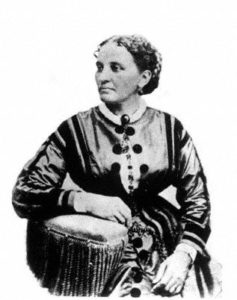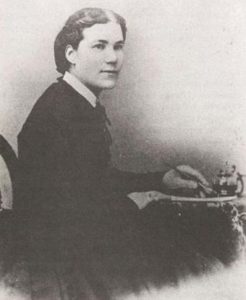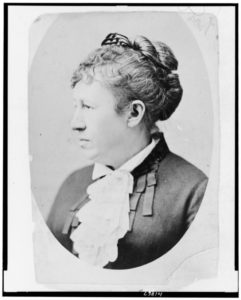On March 8th, 2018, for International Women’s Day The New York Times launched “Overlooked,” a series of obituaries of notable women in history who never received their due. They noted that “since 1851, obituaries in The New York Times had been dominated by white men. Now, we’re adding the stories of remarkable women.”
In the spirit of the The New York Times’ reckoning, our article this month focuses on three incredibly smart, brave, and influential women during the Civil War who, in our opinion, never received their due either. Read on for our obituaries of these women, a special tribute to their influences and accomplishes that changed the course of history.
by Joan Cummins
Elizabeth Keckly (1818-1907)
The Ancient Greeks held that the Fates would snip your thread at your life’s end. At her passing at age 89, Elizabeth Keckly was intimately familiar with the threads of life. A dressmaker, small business owner and a prominent member of the Washington, DC African American community, she began her life in slavery in Virginia.
As a child and a young adult, Elizabeth was enslaved by the Burwell family, who assigned her nursemaid duties beginning at the age of four and sewing tasks thereafter. The Burwells moved from Virginia to Missouri in 1847. Elizabeth and her mother Agnes accompanied them, though her mother’s beloved husband George was forced to remain behind because a different family enslaved him. In 1855, Elizabeth, often called Lizzy, raised an enormous sum of $1,200 via her dressmaking work in St. Louis to purchase her own freedom and that of her son, George. She then moved to Washington, DC.
Mrs. Keckly’s dressmaking business prospered in Washington, where she constructed elaborate gowns for the city’s most prominent ladies, including Mrs. Stanton, Mrs. Seward, and most famously for Mrs. Mary Lincoln. Mrs. Keckly and Mrs. Lincoln became intimate friends, and the First Lady relied on Elizabeth for emotional support after her husband’s assassination. Although their relationship would later be marred by the drama surrounding the Old Clothes Scandal, Mrs. Keckly ever remembered Mrs. Lincoln fondly. During the war, Mrs. Keckly (sometimes also spelled “Keckley”) organized and served as the president of the Contraband Relief Association, a charitable organization benefiting refugees from slavery in the city.
She was predeceased by her son George, killed in action while serving in the Union Army. George, whose father had been a white man who forced himself on Elizabeth, passed as white in order to enlist. Mrs. Keckly, a staunch advocate for African-Americans to serve in the military, fought to be awarded his pension and was successful.
Among her other accomplishments, Mrs. Keckly organized an exhibition for the Chicago World’s Fair, mentored young black women in sewing and dressmaking, and published a memoir, Behind the Scenes: Thirty Years a Slave and Four in the White House, in 1868. She has no surviving immediate relatives.
To learn more about Elizabeth Keckly, read her memoir Behind the Scenes or Mrs. Lincoln & Mrs. Keckly, by Jennifer Fleischner, both available in the PLC museum store.
Sarah Emma Edmonds (1841-1898)
Many of us dream of living a life of adventure, but Sarah Emma Edmonds actually lived that dream. Ingenious and intrepid, she is among the most famous of the unknown number of women who dressed as men and fought in the Civil War. She died of complications from malaria at her home in Texas in 1898, at the age of 57.
Born and raised in New Brunswick, Canada, Edmonds fled her home as a teenager to avoid an arranged marriage to a neighbor twice her age. To increase her safety on the road, she dressed in men’s clothing and went by the name of Frank Thompson. Frank crossed the border into the United States, sold books, and did odd jobs before enlisting in the army after the outbreak of the Civil War. She served in Company F of the 2nd Michigan Infantry.
As Frank Thompson, Emma worked as a nurse with her unit in Virginia, assisted with the retreat from First Manassas, and served as a courier, a fast-paced and dangerous assignment. After the death of her friend James Vesey, she signed up as an espionage agent and sought intelligence on Confederate fortifications and positions around Richmond. She variously disguised herself as a black male contraband worker, an Irish woman, and a male detective over the course of her spying career. In 1863, Edmonds became ill, and “Frank Thompson” left his unit to recuperate. Edmonds, on her recovery, decided not to rejoin the army, as Thompson had been listed as a deserter and she risked execution as a punishment. She instead joined nursing services once again, this time using her own identity.
In 1867 Edmonds married, and though she and her husband Linnus H. Seelye lost three children as infants, they adopted two sons who survived her. Her petition to the federal government to receive her veteran’s pension revealed her true identity and corrected the record on Thompson’s supposed desertion. Her pension was granted by special act of Congress. She was the first woman to be inducted into the Grand Army of the Republic, an association for veterans of the Civil War.
Curious about Sarah Emma Edmonds? Stealing Secrets, by H. Donald Winkler, contains stories of her and many other women in Civil War espionage and is available in the PLC museum store.
Julia Dent Grant (1826-1902)
Having lived to see the dawn of a new century, Julia Grant passed away in 1902 at the age of 76. She bolstered her husband through his difficult military campaigns, expanded the role of the First Lady, and traveled the world.
Julia grew up in Missouri in a relatively well-off slaveholding family. Her enslaved playmates would later be gifted to her by her father. In 1848 she married Ulysses S. Grant, after an extended courtship correspondence while he was fighting in the Mexican-American War. The pair loved each other deeply; Julia described him as “the nicest and handsomest man I ever saw,” and Ulysses, when Julia fretted that her crossed eyes should be corrected as she was to become the First Lady, said “Did I not see you and fall in love with you with these same eyes?” During the Civil War, Julia traveled over ten thousand miles to and from her husband’s stations to support him, sometimes with her children in tow. Her presence was such a benefit to his mental health that Lincoln sent for Julia when he first appointed Grant commander of the Union Army. Grant described her as a source of “sunshine.”
As First Lady, Julia shone, hosting myriad events, bringing the furnishings in the White House up to date, and enclosing a back garden for her children’s use. She and her husband traveled Europe together after his presidency, and though they later struggled through a financial disaster and his throat cancer, he rushed to finish his memoirs before his death to ensure she and their family would be financially supported. Julia would later go on to write her own memoirs, and is the first First Lady to have done so.
Julia Grant was survived by her four children, Frederick, Ulysses, Nellie, and Jesse, and twelve grandchildren. She is buried alongside her husband in his tomb.
To find out more about Julia Grant and her role in the Civil War, explore Lincoln’s General’s Wives by Candace Shy Hooper, our Team Lincoln spotlight for this month.



